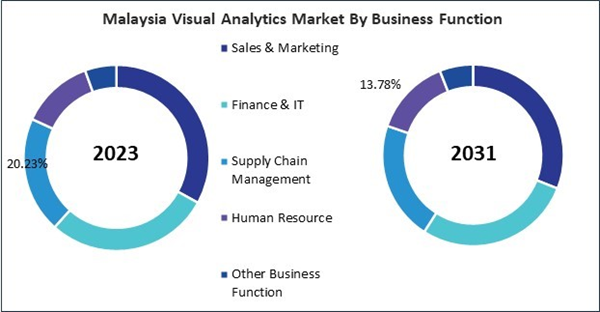The China market dominated the Asia Pacific Visual Analytics Market by country in 2023, and is expected to continue to be a dominant market till 2031; thereby, achieving a market value of $1.59 billion by 2031. The Japan market is exhibiting a CAGR of 17.3% during 2024-2031. Additionally, the India market is expected to experience a CAGR of 18.8% during 2024-2031.
The adoption of visual analytics solutions is witnessing a steep rise due to the increasing emphasis on data-driven decision-making. Many organizations invest heavily in visual analytics to stay competitive in an increasingly data-centric world. The increasing volume and complexity of data generated by businesses and individuals are compelling organizations to seek advanced tools for analysis. Traditional data analysis methods often fail to handle the scale and complexity of big data. Visual analytics helps bridge this gap by providing intuitive ways to interpret massive datasets.
The demand for real-time analytics is another key driver of visual analytics adoption. In fast-paced industries such as finance, retail, and manufacturing, the ability to make quick, data-driven decisions is essential for maintaining a competitive edge. Visual analytics allows decision-makers to access and interpret data instantly, facilitating rapid responses to dynamic business environments. The increasing adoption of cloud computing is also contributing to the growth of the visual analytics market. Cloud-based visual analytics platforms offer scalability, flexibility, and cost-efficiency, making them accessible to organizations of all sizes. Cloud solutions also facilitate collaboration, allowing teams to share insights and collaborate on data analysis in real-time.
India’s fintech sector is undergoing explosive growth. It is projected to reach $150 billion by 2025, up from $50 billion in 2021, with a total opportunity of $2.1 trillion by 2030. As the fintech industry evolves, it will generate vast amounts of financial data that need to be analyzed and visualized for insights. Visual analytics will be crucial in the fintech sector to analyze trends, detect fraud, predict customer behavior, and optimize financial services.
India’s continued push for digital transformation, with initiatives such as Digital India and the rapid expansion of mobile banking, will further increase the demand for visual analytics solutions. As more financial data is digitized and stored on cloud platforms, fintech companies and financial institutions will require advanced analytics tools to gain insights into customer behavior, financial trends, and operational efficiency. Visual analytics will become crucial to the digital ecosystem, helping businesses stay competitive and provide more efficient, data-driven services. Therefore, the rise of China’s software and IT services industry and the rapid expansion of India’s fintech sector will create significant demand for visual analytics solutions in both countries.
List of Key Companies Profiled
- IBM Corporation
- Oracle Corporation
- SAP SE
- Microsoft Corporation
- SAS Institute Inc.
- Cisco Systems, Inc.
- TIBCO Software, Inc. (Vista Equity Partners Management, LLC)
- Salesforce, Inc.
- Google LLC (Alphabet Inc.)
- Hewlett Packard Enterprise Company
Market Report Segmentation
By Deployment Mode- Cloud
- On-premise
- Solution
- Services
- Professional Services
- Managed Services
- Sales & Marketing
- Finance & IT
- Supply Chain Management
- Human Resource
- Other Business Function
- Large Enterprises
- Small & Medium Enterprises
- BFSI
- Government
- Energy & Utilities
- Healthcare
- Manufacturing
- Retail
- Telecom & IT
- Other Vertical
- China
- Japan
- India
- South Korea
- Australia
- Malaysia
- Rest of Asia Pacific
Table of Contents
Companies Mentioned
- IBM Corporation
- Oracle Corporation
- SAP SE
- Microsoft Corporation
- SAS Institute Inc.
- Cisco Systems, Inc.
- TIBCO Software, Inc. (Vista Equity Partners Management, LLC)
- Salesforce, Inc.
- Google LLC (Alphabet Inc.)
- Hewlett Packard Enterprise Company
Methodology

LOADING...









